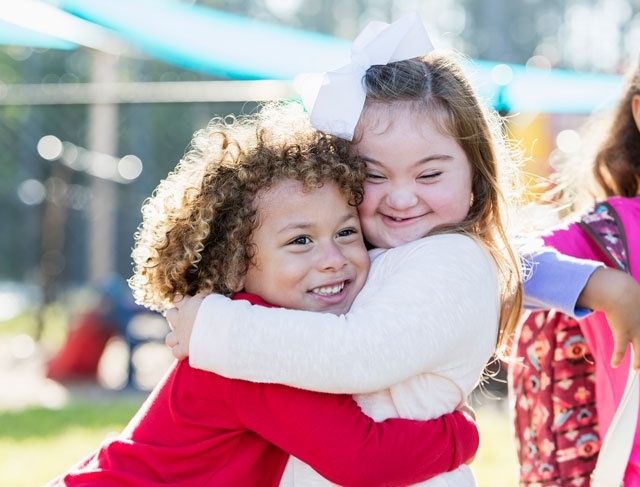Any preschool classroom may include children with disabilities. Some disabilities are apparent, while others are less noticeable. Preschoolers may have disabilities that haven’t yet been detected or diagnosed. Young children can be very accepting of classmates’ diverse abilities, but they may have questions. Teachers can support all the children as they learn to become friends.
Working with children
Talk about the diverse abilities of children in your classroom.
- Be well-informed. Explain clearly, in words preschoolers understand. Emphasize what the child with a disability CAN do. Does the child use special equipment? Name it accurately and describe how it helps. “Ben’s hearing aids make our voices louder and clear so he can understand us.”
- Be alert for mistaken ideas. Some preschoolers think a person who doesn’t walk or see just isn’t trying. They may think, “Their mom forgot to teach them how.” Some worry they might “catch” the disability, as if it were a cold. They may think they can play with the special equipment. Gently correct mistakes right away: “Sophia’s wheelchair isn’t a riding toy to share. It’s how she gets around the room.”
Promote friendships among all the children.
- Lead conversations with the whole class about shared interests. “OK everyone, let’s make a list together of things we like to do. It’s nice to do things with friends.”
- Adjust game rules so a child with a disability can play with classmates. For example, play “I hear” rather than “I spy” to include children with visual disabilities.
- Smile, laugh, and play with a child who has a disability. Besides helping the child feel welcome and valued, you let their classmates see that they can do the same.
- Find ways to let children know when a child’s disability involves discomfort with some interactions. For example, a child with autism may prefer a thumbs-up to a hug or high five.
Be sure classroom materials depict people with diverse abilities, including disabilities not represented in your classroom.
- Explore the library for books and videos featuring people with disabilities.
- Invest in dolls and play figures that come with crutches and other disability aids.
Working with families
Ask what a child’s family wants others to know about the disability.
- Do they want to talk to the class, or let the child explain? Or do they want you to do it?
- Keep in mind that some disabilities have involved trauma to the child or family. This may affect what they want to say about it.
Let all families know that disability is a natural part of the human experience and that your classroom is a safe, inclusive space for all children.


 PDF
PDF